|
 |
 |
 |
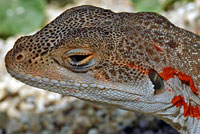 |
 |
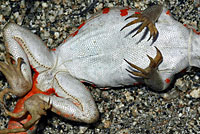 |
 |
| Adult female showing orange breeding colors, San Diego County © Gary Nafis Specimen courtesy of Robert Applegate |
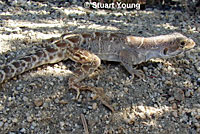 |
 |
 |
| Adult males, San Diego County © Stuart Young |
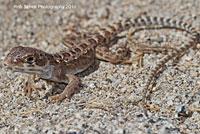 |
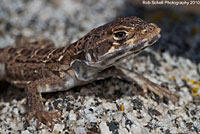 |
 |
| |
Adult, San Diego County © Rob Schell |
|
| |
 |
|
| |
Leopard Lizards, genus Gambelia, have granular scales on the body. |
|
| |
|
|
| Habitat |
 |
 |
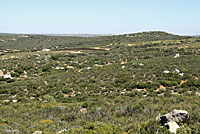 |
Habitat, San Diego County
|
Habitat, San Diego County
|
Habitat, San Diego County
|
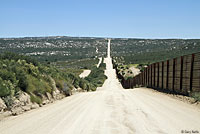 |
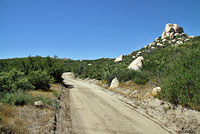 |
 |
Habitat, San Diego County
|
Habitat, San Diego County
|
Habitat, San Diego County
|
|
|
|
| Description |
| |
| Size |
Up to 5 inches (126 mm)in length from snout to vent.
Females grow larger than males.
|
| Appearance |
A large lizard with a big triangular head, wider than the neck, which contains folds on the sides.
The nose is elongated slightly.
|
| Color and Pattern |
Color is dark gray to light or dark brown, overlaid with large paired dark spots separated by cream colored bars. The dark spots connect on the tail to become dark cross-bands separated by cream bars. The ground color lightens considerably as the lizard's body temperature increases.
Females develop red or orange coloring when gravid.
|
| Life History and Behavior |
Activity |
Diurnal, emerging in the morning to bask.
Sometimes found basking on rocks and road berms.
|
| Defense |
| Besides running away, sometimes flattens the body to rely on cryptic coloring to hide from a predator. |
| Diet and Feeding |
| Eats lizards and arthropods, which are caught by ambush, or sitting and waiting for the prey to pass by closely. |
| Reproduction |
Mates from April to July. Eggs are probably laid in the Summer.
|
| Habitat |
In California, inhabits coastal sage scrub, chaparral, and oak woodland.
Prefers flat areas with open space for running, avoiding densely vegetated areas.
|
| Geographical Range |
Gambelia copei is a Baja California species, ranging throughout most of Baja California, and coming into California only in the extreme southwest part of the state around Cameron Corners, Campo, and the Potrero Grade.
|
 |
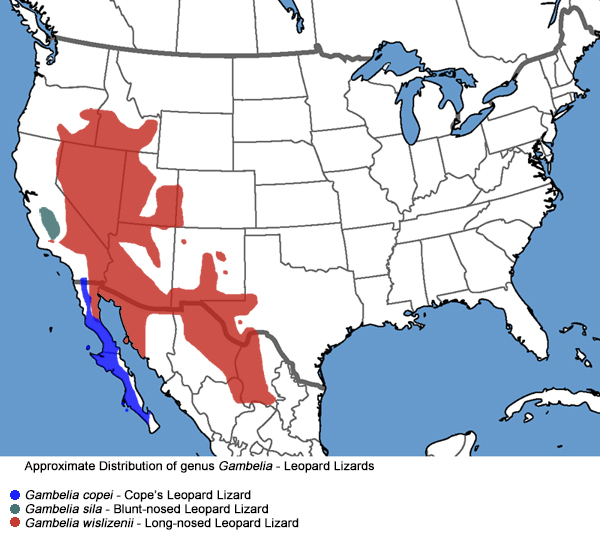
|
| Notes on Taxonomy |
There are two common names in use for this lizard - Cope's Leopard Lizard, and Baja California Leopard Lizard, with Cope's being more widely used in the literature and online sources as I write this in January, 2025. Nevertheless, I have changed the common name on this website to Baja California Leopard Lizard for a few reasons: it is used now in Hansen and Shedd's 2025 California field guide, in Wikipedia, in Grismer's Guide to Baja California herps (and in Marcy, 2025, in the new SSAR list); the range of the species is primarily in Baja California with only a very small incursion into southern California; and mostly because I dislike common name eponyms. The possessive name "Cope's" makes it appear that the species belongs to Cope. He is already honored in the Latin name so in my opinion it is much better if the common name is more descriptive of the species.
Gambelia copeii - Baja California
Leopard Lizard (Nicholson, K. E. (ed.). 2025 SSAR Scientific and Standard English Names List)
Gambelia copeii - Baja California
Leopard Lizard (Hansen and Shedd 2025)
Gambelia copeii - Baja California Leopard Lizard (Grismer 2002)
Gambelia copeii - Baja California Leopard Lizard (Wikipedia 1/25)
---------------------------------------------------------------------------------------------------------------------------------------------------------------------
"The standard English name of this species has been changed to improve the information content of the name as well as to remove a potentially offensive eponym."
(Nicholson, K. E. (ed.). 2025 SSAR Scientific and Standard English Names List)
---------------------------------------------------------------------------------------------------------------------------------------------------------------------
Alternate and Previous Names (Synonyms)
At one time considered a subspecies of Gambelia wislizenii.
Gambelia copeii - Cope's Leopard Lizard (CA Dept. Fish and Wildlife 1/25)
Gambelia copeii - Cope's Leopard Lizard (Reptile Database 1/25)
Gambelia copeii - Cope's Leopard Lizard (Stebbins & McGinnis 2012, and 2018)
Gambelia copeii - Cope's Leopard Lizard (Lizards of the American Southwest 2009)
Gambelia copeii - Cope's Leopard Lizard Stebbins 2003)
(From the Reptile Database)
Crotaphytus copeii YARROW 1882
Crotaphytus copii — GARMAN 1884
Gambelia wislizeni copei — BANTA & TANNER 1968
Gambelia wislizeni neseotes BANTA & TANNER 1968
Gambelia wislizeni copeii — BOSTIC 1971
Gambelia wislizenii copeii — LINER 1994
Gambelia wislizenii copei — GRISMER et al. 1994
Gambelia copeii — MCGUIRE 1996
Gambelia copeii — CROTHER 2000
Gambelia copeii — COLLINS & TAGGART 2009
Gambelia copeii — HEIMES 2022
|
| Conservation Issues (Conservation Status) |
| None |
|
|
Taxonomy |
| Family |
Crotaphytidae |
Collared and Leopard Lizards |
Smith & Brodie, 1982 |
| Genus |
Gambelia |
Leopard Lizards |
Baird 1859 “1858” |
Species
|
copeii |
Baja California Leopard Lizard |
(Yarrow, 1882) |
|
Original Description |
Gambelia wislizenii copeii - (Yarrow, 1882) - Proc. U.S. Natl. Mus., Vol. 5, p. 441
from Original Description Citations for the Reptiles and Amphibians of North America © Ellin Beltz
Eponyms
First described by H. C. Yarrow, the specific name "Gambelia copei" and the common name "Cope's Leopard Lizard" honor Edward Drinker Cope (1840-1897) an American zoologist, paleontologist, comparative anatomist, herpetologist, and ichthyologist. (Cope returned the favor in 1875 and named Sceloporus jarrovi in honor of Yarrow.)
See: Biographies of Persons Honored in the Herpetological Nomenclature © Ellin Beltz
|
|
Meaning of the Scientific Name |
Gambelia - honors Gambel, William
copei - honors Cope, Edward Drinker
from Scientific and Common Names of the Reptiles and Amphibians of North America - Explained © Ellin Beltz
|
|
Related or Similar California Lizards |
Long-nosed Leopard Lizard - Gambelia wislizenii
Blunt-nosed Leopard Lizard - Gambelia sila
|
|
More Information and References |
California Department of Fish and Wildlife
San Diego Natural History Museum
Hansen, Robert W. and Shedd, Jackson D. California Amphibians and Reptiles. (Princeton Field Guides.) Princeton University Press, 2025.
Stebbins, Robert C., and McGinnis, Samuel M. Field Guide to Amphibians and Reptiles of California: Revised Edition (California Natural History Guides) University of California Press, 2012.
Stebbins, Robert C. California Amphibians and Reptiles. The University of California Press, 1972.
Flaxington, William C. Amphibians and Reptiles of California: Field Observations, Distribution, and Natural History. Fieldnotes Press, Anaheim, California, 2021.
Nicholson, K. E. (ed.). 2025. Scientific and Standard English Names of Amphibians and Reptiles of North America North of Mexico, with Comments Regarding Confidence in Our Understanding. Ninth Edition. Society for the Study of Amphibians and Reptiles. [SSAR] 87pp.
Samuel M. McGinnis and Robert C. Stebbins. Peterson Field Guide to Western Reptiles & Amphibians. 4th Edition. Houghton Mifflin Harcourt Publishing Company, 2018.
Stebbins, Robert C. A Field Guide to Western Reptiles and Amphibians. 3rd Edition. Houghton Mifflin Company, 2003.
Behler, John L., and F. Wayne King. The Audubon Society Field Guide to North American Reptiles and Amphibians. Alfred A. Knopf, 1992.
Robert Powell, Roger Conant, and Joseph T. Collins. Peterson Field Guide to Reptiles and Amphibians of Eastern and Central North America. Fourth Edition. Houghton Mifflin Harcourt, 2016.
Powell, Robert., Joseph T. Collins, and Errol D. Hooper Jr. A Key to Amphibians and Reptiles of the Continental United States and Canada. The University Press of Kansas, 1998.
Bartlett, R. D. & Patricia P. Bartlett. Guide and Reference to the Turtles and Lizards of Western North America (North of Mexico) and Hawaii. University Press of Florida, 2009.
Jones, Lawrence, Rob Lovich, editors. Lizards of the American Southwest: A Photographic Field Guide. Rio Nuevo Publishers, 2009.
Smith, Hobart M. Handbook of Lizards, Lizards of the United States and of Canada. Cornell University Press, 1946.
Taylor, Emily. California Lizards and How to Find Them. Heyday, Berkeley, California. 2025.
Grismer, L. Lee. Amphibians and Reptiles of Baja California, Including Its Pacific Islands and the Islands in the Sea of Cortés. The University of California Press, 2002.
McPeak, Ron H. Amphibians and Reptiles of Baja California. Sea Challengers, 2000.
Samuel M. McGinnis and Robert C. Stebbins. Peterson Field Guide to Western Reptiles & Amphibians. 4th Edition. Houghton Mifflin Harcourt Publishing Company, 2018.
Stebbins, Robert C. A Field Guide to Western Reptiles and Amphibians. 3rd Edition. Houghton Mifflin Company, 2003.
The Reptile Database
|
|
|
The following conservation status listings for this animal are taken from the July 2025 State of California Special Animals List and the July 2025 Federally Listed Endangered and Threatened Animals of California list (unless indicated otherwise below.) Both lists are produced by multiple agencies every year, and sometimes more than once per year, so the conservation status listing information found below might not be from the most recent lists, but they don't change a great deal from year to year.. To make sure you are seeing the most recent listings, go to this California Department of Fish and Wildlife web page where you can search for and download both lists:
https://www.wildlife.ca.gov/Data/CNDDB/Plants-and-Animals.
A detailed explanation of the meaning of the status listing symbols can be found at the beginning of the two lists. For quick reference, I have included them on my Special Status Information page.
If no status is listed here, the animal is not included on either list. This most likely indicates that there are no serious conservation concerns for the animal. To find out more about an animal's status you can also go to the NatureServe and IUCN websites to check their rankings.
Check the current California Department of Fish and Wildlife sport fishing regulations to find out if this animal can be legally pursued and handled or collected with possession of a current fishing license. You can also look at the summary of the sport fishing regulations as they apply only to reptiles and amphibians that has been made for this website.
|
| Organization |
Status Listing |
Notes |
| NatureServe Global Ranking |
G5 |
Secure |
| NatureServe State Ranking |
S1S2 |
Critically Imperiled - Imperiled |
| U.S. Endangered Species Act (ESA) |
None |
|
| California Endangered Species Act (CESA) |
None |
|
| California Department of Fish and Wildlife |
SSC |
Species of Special Concern |
| Bureau of Land Management |
None |
|
| USDA Forest Service |
None |
|
| IUCN |
LC |
Least Concern |
|
|
























